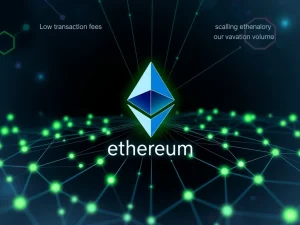Massive Ethereum Validator Withdrawals: $10 Billion Exodus Sparks ETH Price Debate

Ethereum’s staking landscape recently witnessed a pivotal shift. A staggering $10 billion in Ethereum validator withdrawals queued for exit, marking an unprecedented record. This significant event sparks vital questions about the future trajectory of ETH price and the network’s long-term stability. While the sheer volume of withdrawals has raised eyebrows, a deeper look reveals a complex interplay of market dynamics and robust institutional engagement.
Unpacking the Surge in Ethereum Validator Withdrawals
Ethereum recorded its largest validator exit on record this week. Over 2.4 million Ether, valued at more than $10 billion, awaited withdrawal from its proof-of-stake network. This surge in Ethereum validator withdrawals extends the queue time significantly. According to blockchain data from ValidatorQueue.com, the wait now stretches to over 41 days and 21 hours. Validators perform a critical function; they add new blocks and verify transactions, maintaining the integrity of the Ethereum network.
Ether validator queue. Source: validatorqueue.com
The primary reasons behind these withdrawals are multifaceted. Many early stakers, who locked their Ether before the Shapella upgrade enabled withdrawals, are now realizing profits. The price of Ether has shown remarkable growth over the past year. Furthermore, some validators may simply rebalance their portfolios or move their staked assets to other protocols. Understanding these motivations helps to contextualize the current market activity.
Navigating Potential ETH Price Impacts
The surge in pending withdrawals has certainly sparked renewed concern over potential sell pressure for Ether holders. This does not automatically mean all validators seek to take profit. However, a significant portion of the $10 billion may enter the market. Consider that Ether’s price has risen 83% over the past year, according to Crypto News Insights’s price index. This substantial gain provides a clear incentive for some to sell. Consequently, market participants closely monitor the situation for its immediate impact on the ETH price.
ETH/USD, one-year chart. Source: Crypto News Insights
Adding to these concerns, the validator exit queue is approximately five times larger than the Ethereum entry queue. The entry queue currently holds over 490,000 Ether designated for staking. This process has a shorter wait time of eight days and 12 hours. This disparity highlights a short-term imbalance between new capital entering staking and existing capital exiting. However, this dynamic is not necessarily a long-term threat.
Ethereum entry queue versus exit queue. Source: validatorqueue.com
Grayscale Ethereum: A Counterbalancing Force in Staking
Despite the short-term selling pressure concerns, the $10 billion withdrawal does not threaten the Ethereum network’s fundamental stability. The network still boasts over one million active validators. These validators collectively stake 35.6 million Ether, representing 29.4% of the total supply. Crucially, institutional participants are stepping in to replace the exodus. For instance, Grayscale recently made significant moves. On Tuesday, Grayscale staked $150 million in Ether. This action followed the crypto-focused asset manager’s introduction of staking for its Ether exchange-traded products. This made it the first US-based crypto fund issuer to offer staking-based passive income for its funds. This initiative significantly bolsters the attractiveness of Grayscale Ethereum offerings.
On Wednesday, Grayscale deposited another 272,000 Ether, worth $1.21 billion, into the staking queue. According to onchain analyst EmberCN, the company now accounts for ‘the majority of coins currently awaiting staking activation.’ This strategic move by Grayscale underscores growing institutional confidence in Ethereum. It also provides a substantial counterbalance to the record withdrawals. Such institutional commitment helps to stabilize the market.
Source: EmberCN
The Rise of Institutional Ethereum Adoption
Beyond Grayscale’s direct actions, a broader trend of Institutional Ethereum adoption continues to gather momentum. Iliya Kalchev, a dispatch analyst at digital asset platform Nexo, shared insights with Crypto News Insights. He noted that institutional and corporate treasuries now hold over 10% of ETH’s total supply. Furthermore, October ETF inflows have already exceeded $620 million. This sustained influx of institutional capital signals a maturing market. It reflects a growing recognition of Ethereum’s utility and potential.
Kalchev further explained, “The data reflect Ethereum’s evolution into a yield-bearing, institutionally recognized asset used both for infrastructure and collateral purposes.” This evolution positions Ethereum not just as a speculative asset, but as a foundational component of the future financial landscape. Institutional players value its utility for decentralized applications (DeFi) and its ability to generate passive income through Ethereum staking. This long-term view contrasts sharply with short-term market fluctuations.
Ensuring Ethereum Network Stability Amidst Flux
The robust underlying infrastructure of Ethereum provides significant resilience. Even with substantial Ethereum validator withdrawals, the network maintains a vast pool of active validators. The ongoing commitment to Ethereum staking by a diverse range of participants, including large institutions, reinforces its security model. The proof-of-stake mechanism inherently encourages long-term participation. It rewards validators for their contribution to network security and decentralization. This foundational strength prevents single events, however large, from destabilizing the entire system.
In conclusion, while the $10 billion in Ethereum validator withdrawals represents a notable event, it forms part of a larger, more complex narrative. The potential for short-term ETH price volatility exists. However, the substantial and growing institutional interest, exemplified by firms like Grayscale, provides a powerful counter-narrative. Ethereum continues to evolve, solidifying its position as a critical, yield-bearing asset within the global financial ecosystem. This dual perspective offers a comprehensive view of Ethereum’s current standing and future trajectory.









